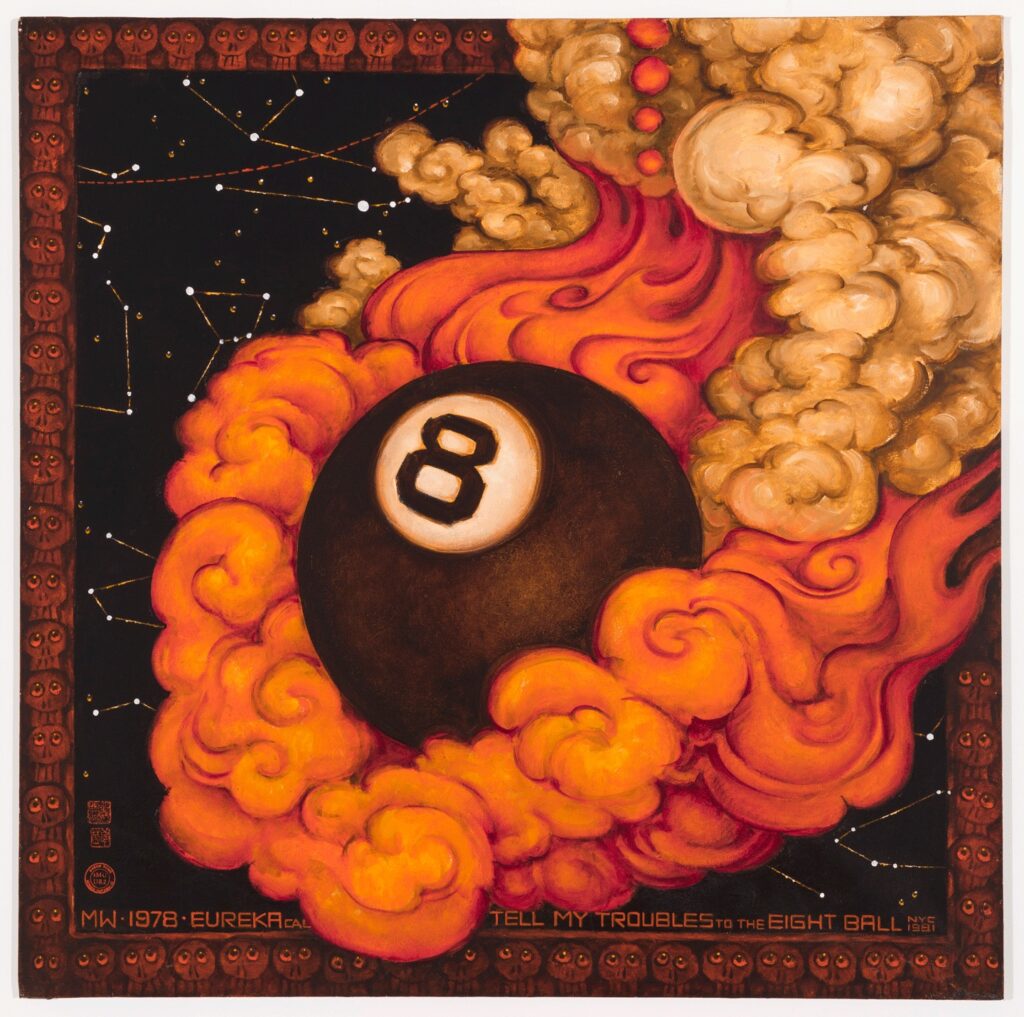Curatorial text
Martin Wong
Malicious Mischief
25 February – 14 May 23
Curator: Krist Gruijthuijsen, Agustín Pérez Rubio
Assistant Curator: Sofie Krogh Christensen
Beginnings on the West Coast
In the early years of his artistic practice, Martin Wong studied ceramics and printmaking at Humboldt State University, California. He was likewise influenced by the passion he shared with his mother, Florence Wong Fie, for antique and pop-cultural objects, as well as ancient Chinese ceramics. Wong found a kinship in Chinese cultural expressions in calligraphy, which became an aesthetic that he would continuously adapt in his poetry scrolls.
In the late 1960s, Wong became part of the theater group The Cockettes, and in the early 1970s he joined their breakout group Angels of Light Free Theater producing sets and costumes that reflected the collective’s interest in expanded perceptions, utopia, Hindu Kaliyuga, psychedelics, and queer self-expression. Drawing on the iconography he encountered during his travels to Europe, India, and Afghanistan, Wong developed an impressive symbolic system inspired by Tantric painting and Kufic architecture, amongst others.
During his formative years on the West Coast, Wong dived into the American counterculture with its drugs, free love, collectivity, and theatrical performance, portraying both the urban environments he ventured through as well as the characters he met along the way.
In 1975, Wong establishes his “Human Instamatic” portrait business, charging $5 for a hand-drawn portrait and $25 for a painted one. His community-oriented drawings from this period focus on capturing Eureka’s crab fishermen, SRO hotel lobbies, bars, and friends in a community threatened by gentrification.
As Wong’s practice turned more towards painting, he started exploring the visual tropes of ‘chance’ and ‘destiny,’ by including stellar constellations, dice, and the eight ball, as seen in his painting Tell My Troubles to the Eight Ball (Eureka) (1978).
Eventually breaking with the Angels of Light Free Theater in 1973, he moved back to Humboldt County. In 1978, Wong decided to pursue his artistic career and moved to New York.
Martin Wong, My Secret World 1978—81, 1984, Acrylic on canvas, 121,92 x 172,72 cm, Courtesy of the Martin Wong Foundation and P.P.O.W, New York © Martin Wong Foundation
Moving to New York
In New York, Martin Wong settled in the former Meyer’s Grand Hotel at the South Street Seaport in 1978, where he would remain for nearly three years, working as a night porter, which provided him free lodging. Using a hotel room as studio, Wong dedicated himself to the medium of painting and kept an fast production pace, which would last for the remainder of his career. Moving from the colorful and utopic San Francisco to the more bleak, dilapidated New York City, the artist’s first years on the East Coast became an intimate period dominated by isolation, reading, listening, and learning. He was a voracious consumer of books on astrology, mythology, Asian identity, sports, male erotica, magazines, and newspapers. His seminal work My Secret World (1978–1981) (1984) refers to these early years at Meyer’s Hotel through a trompe l’oeil, providing a voyeuristic view into his world.
Like in San Francisco, Wong drew his inspiration from his immediate surroundings and the encounters he made in these urban settings. One day, while riding the subway, a Deaf person from New York approached the artist with a pamphlet displaying the American Sign Language (ASL) fingerspelling alphabet. Using ASL to spell out salacious headlines about the media spectacles as reported in tabloid newspapers like Weekly World News, Wong created further seminal works such as Psychiatrists Testify: Demon Dogs Drive Man to Murder (1980) and Clones of Bruce Lee (1981). This moment would prove to be pivotal to the artist’s practice, and the gesticulating hands of ASL would become a signature aesthetic and a keystone in his cosmos of codes, providing voices to his peers and local minority groups.
Martin Wong, Mrs. Liberty Face, 1990, Acryl auf Leinwand, 80,1 x 118,11 cm, Courtesy die Martin Wong Foundation und P.P.O.W, New York, und Galerie Buchholz © Martin Wong Foundation
Loisaida
In 1982, Martin Wong moved to Ridge Street on Manhattan’s Lower East Side, known at the time as ‘Loisaida.’ Loisaida was a working-class neighborhood predominantly inhabited by Puerto Ricans surrounded by dilapidated architecture, petty criminality, drugs, and burgeoning urban creativity. Wong soon found an affinity with the Nuyorican (a composite of ‘New York’ and ‘Puerto Rican’) community and frequented a number of the alternative cultural spaces. He struck up decisive friendships with its artists – both graffiti artists as well as poets.
At The Crime Show at ABC No Rio in 1983, Wong met the Nuyorican poet, playwright, and actor Miguel Piñero (1946–1988), and the two developed a deep bond with each other. Piñero, who also was a petty criminal, drug dealer, and community activist, introduced Wong to Loisaida. Being the co-founder of the ‘Nuyorican Poets Café’ on the Lower East Side and the author of the theater play Short Eyes (1974), Piñero became a lasting inspiration for Wong, who began incorporating poetry and imagery from Piñero’s work into his paintings. A good example of this mixture can be seen in Portrait of Miguel Piñero (1982); King Heroin (1983–1984); or Pedro’s Lament (1984).
The reddish-brown tenement bricks found on most of the architecture of the Lower East Side dominated Wong’s aesthetic during this period – often in the manner of tableaux vivants such as No Es Lo Que Has Pensado… (It’s Not What You Think…) (1984) – and became symbolic of his practice in general.
From 1982−1988, Wong’s paintings and painted objects mostly depicted the social reality of his direct surroundings – urban decay and displacement due to gentrification as well as street culture, crimes, drug addiction or the constant presence of fire and police sirens – but also a life amidst a community of immigrants, who were building a new home for themselves despite all odds. This can be seen in the architectural views of Nocturne at Ridge Street and Stanton (1987) or in Chinese Laundry (A Portrait of the Artist’s Parents) (1984). On the other hand, Wong’s erotic fantasies about Latino men slowly became more explicitly present within the paintings. We can also observe it as an abstract form in paintings such as Heaven (1988).
Martin Wong, Malicious Mischief, 1991, Acrylic on canvas, Courtesy of the Martin Wong Foundation and P.P.O.W, New York © Martin Wong Foundation
The last picture show
In 1986, Martin Wong opened his third exhibition at the Semaphore Gallery, directed by Barry Blinderman, titled The Last Picture Show. Throughout the previous year, he had begun to paint life-size façades and storefronts – closed establishments with their lowered shutters and gates. Wong presented an immersive installation composed by ten storefronts standing on the floor, physically reconstructing the walk along Avenue B and portraying the urban change of the Lower East Side. A selection of these original paintings are on show here.
In the press release, Wong proclaimed that “everything must go.” The installation questioned the destruction and reconstruction that was brought to the area through increasing gentrification.
Martin Wong, Psychedelic Triptych, 1988, Acrylic on canvas, triptych, 242,9 x 350,5 x 4,6 cm, Courtesy of the Martin Wong Foundation and P.P.O.W, New York © Martin Wong Foundation
Prisoners, policemen, firemen, and graffiti artists
Through his affinity with Miguel Piñero and his friendship circle, Wong was frequently confronted with the reality of the American police, prisons, and the surveillance state as well as the influence of race, class, and sexual politics on power dynamics, among inmates, and between inmates and supervisors. In paintings like Penitentiary Fox (1988) – a tribute to Piñero after his death that year, who is portrayed in the lower center of the image, and to his fellow prisoners/cast members of his play Short Eyes – or in Lock Up (1985) and Malicious Mischief (1991), Wong offered an unadorned view into the insides of prisons, in which occupied cells, spaces of intimacy, violence and homosexual desire, are revealed. Especially within those infrastructures that maintain hegemonic power structures, such as urban planning, police, and prison state or fire departments, Wong continuously found room for intimacy, eroticism, desire, and imagination – as seen in I Really Like the Way Firemen Smell (1988) or Come Over Here Rockface (1994), among others. This critical appropriation also connects him to tactics of empowerment of New York’s gay scene at the time.
While living in Loisaida, Wong formed long-lasting friendships with prominent members the New York graffiti scene—like Christopher “Daze” Ellis, Sharp, LA2, and Lady Pink—most of whom he met through his part-time job at the legendary store Pearl Paint on Chinatown’s Canal Street. He later expanded his collecting practice by adding an impressive number of graffiti sketchbooks, or piece books, from this group of artists, financially supporting the scene—and in 1988, Wong inaugurated the short-lived Museum of American Graffiti with friend Peter Broda. Wong’s graffiti collection was later donated to the Museum of the City of New York in 1994.
Martin Wong, Did I Ever Have a Chance, 1999, Acrylic on canvas, 154,9 x 121,9 cm, Courtesy of the Martin Wong Foundation and P.P.O.W, New York © Martin Wong Foundation
The last years: The chinatown paintings and after
Revisiting a subject he first explored in the 1970s, Wong created an expansive body of work about Chinatown in the early 1990s – a time of politically charged, ethnicity-driven interest in identity. Both drawing on the imageries from New York’s Chinatown as well as that of San Francisco – Grant Avenue, San Francisco (1992) – Wong would likewise integrate personalities, sceneries, and symbols that do not reflect the authentic reality of their inhabitants, but instead reproduce a perfect truism of pop-cultural Chinese-American imaginaries, as seen in Bruce Lee in the Afterworld (1991). Drawing on family and collective memories from the 1930s to the present, these paintings were both an effort to reminisce his childhood and an active attempt to rewrite his history. His paintings of the Statue of Liberty are a fine illustration of the social projection of immigrant people in the USA. In his work, Wong continued to show a fascination with the multiplicity of meanings shared by the erotic, the astrological and the ancient.
In 1994, Wong was hospitalized for pneumonia, which quickly revealed itself to be an HIV/AIDS-related illness. Diagnosed with an advanced stage of the virus, Wong decided to return to his parents’ home in San Francisco to benefit from advanced medicine and his network of friends and family. Despite his rapidly deteriorating health, Wong continued to paint in his family home. On the day of his death, August 12, 1999, he completed his last painting, Did I Ever Have a Chance? (1999), which depicts the iconic kidnapped-and-abducted Patty Hearst transformed into Kali, the Hindu goddess of death and time.
Martin at his solo exhibition at Exit Art, 1988. Photo by Florence Wong Fie. Courtesy of the Martin Wong Foundation
Artist Bio
Martin Wong (1946-1999) was born in Portland, Oregon and raised in San Francisco, California. He studied ceramics at Humboldt State University, graduating in 1968. Wong was active in the performance art groups The Cockettes and Angels of Light Free Theater before moving to New York in 1978. He exhibited for two decades at notable downtown galleries including EXIT ART, Semaphore, and P·P·O·W, among others, before his passing in San Francisco from an AIDS related illness.
His work is represented in the collections of The Metropolitan Museum of Art, Museum of Modern Art, The Bronx Museum of the Arts, Whitney Museum of American Art (all New York). As well as Cleveland Museum of Art, Art Institute of Chicago, and the San Francisco Museum of Modern Art, among others. The exhibition Human Instamatic opened at the Bronx Museum of The Arts in November 2015, before traveling to the Wexner Center for the Arts in 2016 and the UC Berkeley Art Museum and Pacific Film Archive in 2017.
Martin Wong, Tell My Troubles to the Eight Ball (Eureka), 1978—81, Acrylic on canvas
121,9 x 121,9 cm, Courtesy of the Martin Wong Foundation and P.P.O.W, New York © Martin Wong Foundation
Colophon
Curators: Krist Gruijthuijsen, Agustín Pérez Rubio
Assistant Curator: Sofie Krogh Christensen
Head of Production: Claire Spilker
Technical Management: Wilken Schade
Head of Installation, Media Technology: Markus Krieger
Installation Team: KW Installation Team
Registrar: Monika Grzymislawska
Assistant Registrar: Carlotta Gonindard Liebe
Education and Art Mediation: Laura Hummernbrum, Alexia Manzano
Public Program and Outreach: Nikolas Brummer
Press and Communication: Anna Falck-Ytter, Marie Kube
Text and Editing: Agustín Pérez Rubio, Sofie Krogh Christensen, Krist Gruijthuijsen
Translation and Copy-Edit: Anneliis Beadnell, Hans Georg Hiller von Gaertringen, Sabine Weier
Academic Traineeship: Lara Scherrieble
Interns: Marie Hütter, Janika Jähnisch, Gina Ruhlandt, Antoine Schalk, Carla Veit

Martin Wong – Malicious Mischief is made possible through support from the Terra Foundation for American Art.

The publication and the exhibition at KW are funded by Kulturstiftung des Bundes (German Federal Cultural Foundation). Kulturstiftung des Bundes (German Federal Cultural Foundation) is funded by the Beauftragte der Bundesregierung für Kultur und Medien (German Federal Commissioner for Culture and the Media).
With the generous support of The Martin Wong Foundation, P.P.O.W, New York, KAWS, and Galerie Buchholz.

Martin Wong – Malicious Mischief is initiated by KW Institute for Contemporary Art, Berlin, curated by Krist Gruijthuijsen and Agustín Pérez Rubio, and produced in collaboration with Museo Centro de Arte Dos de Mayo (CA2M), Móstoles, Madrid; Camden Art Centre, London; and Stedelijk Museum Amsterdam.

Media partner








